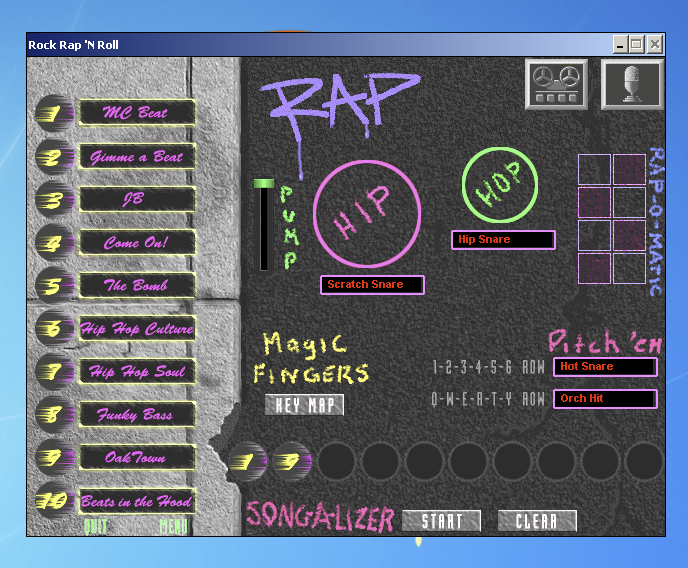Difference between revisions of "Rock Rap n Roll"
(→Project Files & Resources) |
|||
| (One intermediate revision by the same user not shown) | |||
| Line 1: | Line 1: | ||
=Overview= | =Overview= | ||
Rap Rock 'N Roll was an interactive music system created by Paramount Interactive in 1993. Here is what it looked/functioned like running inside of a Windows 7 virtual machine with awful audio latency and glitches:<br> | Rap Rock 'N Roll was an interactive music system created by Paramount Interactive in 1993. Here is what it looked/functioned like running inside of a Windows 7 virtual machine with awful audio latency and glitches:<br> | ||
| − | <youtube>https://youtu.be/akA-BuRlx0U</youtube><br> | + | <youtube>https://www.youtube.com/watch?v=k2g1hNFG9og</youtube> |
| + | <!-- | ||
| + | <youtube>https://youtu.be/akA-BuRlx0U</youtube> | ||
| + | --> | ||
| + | <br> | ||
=A Term 2022 Project= | =A Term 2022 Project= | ||
| Line 13: | Line 17: | ||
* How is the soundport size determined on other instruments? (Martin, Takamine, Taylor, etc.) | * How is the soundport size determined on other instruments? (Martin, Takamine, Taylor, etc.) | ||
<br> | <br> | ||
| + | [[File:RRR_Gui.png|400px]]<br> | ||
| + | |||
===Goals=== | ===Goals=== | ||
The goal of this project is to 1) between the size/shape of an instrument's body with the size/shape/location of the instrument's soundport 2) through a document or '''ideally''' an interactive or simulated element (webpage, MatLab or Ansys file, spreedsheet, etc.), so that when the dimensions for an instrument body are specified the appropriate-sized soundport is produced. | The goal of this project is to 1) between the size/shape of an instrument's body with the size/shape/location of the instrument's soundport 2) through a document or '''ideally''' an interactive or simulated element (webpage, MatLab or Ansys file, spreedsheet, etc.), so that when the dimensions for an instrument body are specified the appropriate-sized soundport is produced. | ||
Latest revision as of 16:47, 28 June 2022
Contents
Overview
Rap Rock 'N Roll was an interactive music system created by Paramount Interactive in 1993. Here is what it looked/functioned like running inside of a Windows 7 virtual machine with awful audio latency and glitches:
A Term 2022 Project
Overview
The objective of this prohect is to recreate this interactive application so that it can run inside of a browser.
Guiding Questions:
- What kind of pressure inside of the guitar needs to be alleviated in order for air to flow through the body most efficiently?
- Is there a perfect size soundport where by the instrument's voice becomes louder in certain frequencies than others?
- What happens when the soundport is too small or too large?
- How is the soundport size determined on other instruments? (Martin, Takamine, Taylor, etc.)
Goals
The goal of this project is to 1) between the size/shape of an instrument's body with the size/shape/location of the instrument's soundport 2) through a document or ideally an interactive or simulated element (webpage, MatLab or Ansys file, spreedsheet, etc.), so that when the dimensions for an instrument body are specified the appropriate-sized soundport is produced.
Project Outcomes
Summary of project outcomes
Overview
summary of process and scope goes here
Resources
Summary of methods and resources used/developed goes here. Photos, figures, and videos are helpful—and you can link Git repos and papers in the separate Project Resources section below this.
Future Goals/Recommendations
If you had another year and a million dollar budget to coach a team through the next parts of this project, what insights, resources, and key statements might you give as a starting point for the next team?
Project Files & Resources
Git Repository
All files for this project are stored on the secured repository below. Contact Manzo for access once you've made an account on the Git (see Help).
- Help Connecting to Repository
- Repository address:
- Windows 32-bit version of original program Repository address:
- https://arcgit.wpi.edu/rrr/original.git - unzip and run in a 32-Bit Virtual Machine or OS
